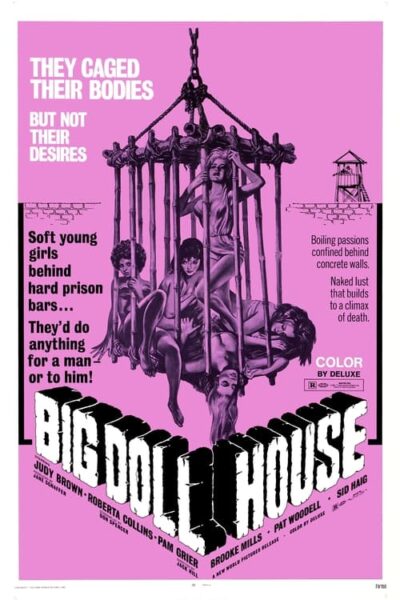 Among women in prison movies THE BIG DOLL HOUSE is one of the biggies. Released in 1971, it was director Jack Hill’s first major hit, and established many of the genre’s clichés (in addition to providing a great deal of footage for Joe Dante and Alan Arkush’s 1976 grindhouse spoof HOLLYWOOD BOULEVARD, whose immortal line “Get it up or I’ll cut if off!” was lifted directly from THE BIG DOLL HOUSE).
Among women in prison movies THE BIG DOLL HOUSE is one of the biggies. Released in 1971, it was director Jack Hill’s first major hit, and established many of the genre’s clichés (in addition to providing a great deal of footage for Joe Dante and Alan Arkush’s 1976 grindhouse spoof HOLLYWOOD BOULEVARD, whose immortal line “Get it up or I’ll cut if off!” was lifted directly from THE BIG DOLL HOUSE).
The film, executive produced by Filipino moviemaking legend Eddie Romero, was the second feature to be released by the Roger Corman founded New World Pictures (following 1970’s THE STUDENT NURSES), and its success inspired tow immediate follow-ups: WOMEN IN CAGES (1971) and the Jack Hill directed BIG BIRD CAGE (1972). THE BIG DOLL HOUSE was also notable for providing the first major role for Pam Grier, who proved so popular with audiences she was given bigger roles in the two follow-ups, and headlined the Hill directed features COFFY (1973) and FOXY BROWN (1974), courtesy of Corman’s former bosses at American International Pictures (Grier, for the record, also sung THE BIG DOLL HOUSE’s theme song “Long-Time Woman,” which wasn’t commercially released but was iconic enough that black radio station programmers played bootleg recordings of it).
It begins with Collier (Judy Brown), a very pretty murderess, being sentenced to a Filipino prison. There, in what would become WIP requisites, she’s forced to wear a very skimpy outfit (with “prison’ stenciled on the back), subjected to a humiliating body cavity search and placed in a cell with several miscreants, whose ranks include the lesbian Greer (played, appropriately, by Pam Grier), the hard-bitten Alcott (B-movie queen Roberta Collins) and the “tough revolutionary” Bodine (Pat Woodell).
Among other indignities, we see Collier getting her head dunked in the cell toilet, a sadistic guard (Kathryn Loder) torturing her charges with live snakes, cat fights proliferating and a group shower session turning violent. An escape plan is hatched by two of Collier’s cell mates in conjunction with a pair of male fruit vendors (one of them played by the late Sid Haig, Hill’s favorite actor), resulting in a lot of miscellaneous gunfire and explosions.
The outrageousness that struck initial viewers has long since worn off (not least because the film has been so widely imitated). What remains striking is Hill’s highly stylized staging, and imagery whose precise emphasis on light and shadow helps obscure the flimsiness of the indoor sets—which appear to have been (and very likely were) made of cardboard.
The exaggerated emoting, a Jack Hill movie fixture, admittedly takes some getting used to (but isn’t as extreme as in later Hill outrages like THE SWINGING CHEERLEADERS and SWITCHBLADE SISTERS). Standout performers include Judy Brown, who’s compelling enough to make one lament that she has so little screen time, and Ms. Grier, whose acting isn’t up to the standards of her later work, but whose outsized screen presence is undeniable.
Further impediments to the suspension of disbelief are the performers’ glammed-up appearances (none of the women in this film look like they’ve set foot outside a Beverly Hills salon, much less inside a Filipino prison). Gritty realism, however, isn’t something we can reasonably expect in the 1970s-era women in prison movie, particularly one made by Jack Hill.
Vital Statistics
THE BIG DOLL HOUSE
New World Pictures
Director: Jack Hill
Producer: Jane Schaffer
Screenplay: Don Spencer
Cinematography: Cliff Fenneman
Editing: Fred Conde
Cast: Judy Brown, Roberta Collins, Pam Grier, Brooke Mills, Pat Woodell, Sid Haig, Christiane Schmidtmer, Kathryn Loder, Jerry Franks, Gina Stuart, Jack Davis, Letty Mirasol, Shirley De Las Alas, Myrna De Vera, Siony Cordona, Kathy McDaniel

